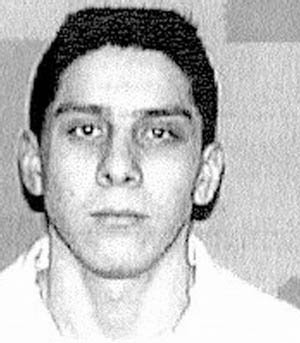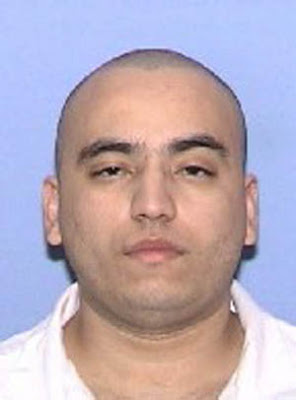Your Texas death machine gets rolling once again
By Jordan Smith / August 1, 2008
A Nation of Laws?
Scheduled for Execution Aug. 5: José Medellín
There is no doubt that the crime for which 33-year-old José Ernesto Medellín was sentenced to die was horrific. And there is no arguing that Medellín did not participate in the brutal gang rape in Houston that claimed the lives of two teen girls. There is also no question that Medellín, a Mexican national, was denied the opportunity after he was arrested to consult with Mexican consular officials regarding his detention and prosecution, as guaranteed under provisions of the 1963 Vienna Convention on Consular Relations, to which the U.S. is a party.
At issue now, just days before his Aug. 5 execution date, is whether that violation of Convention protection prejudiced Medellín’s defense and, more broadly, whether the state of Texas (or any other state) is actually required to enforce the provisions of international law. To international-law experts, including Sarah Cleveland, a former UT law professor who now teaches at Columbia, Texas’ failure to comply with the provisions of international treaties could have far-reaching implications. The U.S. “has relied repeatedly on the enforceability of this and other treaty obligations abroad,” she said. “If we do not keep our promises to our international partners, we lose the ability to protect our own citizens abroad and damage our nation’s reputation as a reliable player on the world stage.”
On June 24, 1993, then-18-year-old Medellín and six other young men gathered in a Houston park for a fight that served as an initiation rite into the Black and White gang. After the fight was over, the teenagers were walking along a set of nearby railroad tracks when they passed two young girls, 14-year-old Jennifer Ertman and 16-year-old Elizabeth Peña. The boys grabbed them; the two girls were raped multiple times, strangled, and left for dead. Medellín was charged, tried, and convicted of capital murder, but it wasn’t until after he was sentenced to death that the Mexican government was contacted about his situation, when Medellín wrote to Mexican officials from his cell.
Ultimately, Medellín was one of 52 people on death row in the U.S. named in a lawsuit filed in the International Court of Justice (often called the “World Court”) by the Mexican government, which argued that the U.S. had failed to meet its obligations under the Vienna Convention on Consular Relations. The relevant section of the Convention provides that in an effort to maintain “international peace and security,” people traveling abroad should have the right to talk with representatives of their home nation “without delay” if arrested, “committed to prison or to custody pending trial or is detained in any other manner.” These rights “shall be exercised in conformity with the laws and regulations” of the detention state, reads the Convention, “subject to the proviso, however, that the said laws … must enable full effect to be given to the purposes” for which the consular rights are intended.
Although Medellín tried to raise the violation of the Convention as a claim on appeal, the courts rejected his argument. In 2001, the Texas Court of Criminal Appeals ruled: 1) that the claim was procedurally moot because Medellín had failed to raise the issue at trial, 2) that as a private individual he didn’t have standing to enforce the provisions of the international treaty, and 3) that he failed to show the violation caused him any harm since he had been provided with “effective legal representation” at trial and that his “constitutional rights were safeguarded.”
Whether Medellín was in fact provided with adequate representation isn’t at all clear. According to court records, one of his court-appointed attorneys was actually suspended from practicing law during the time he was representing Medellín. And the question of whether these violations caused harm to his defense has never been adequately addressed.
While Medellín’s appeal was pending before the federal appeals court, the ICJ ruled that the U.S. had failed to meet its obligations under the Vienna Convention and that the U.S., “by means of its own choosing,” had to have the cases of every Mexican national reviewed by the courts. In response, Bush issued a memorandum on Feb. 28, 2005, that, in essence, ordered the state courts to “give effect” to the ICJ decision. (Bush also subsequently withdrew U.S. participation in the portion of the Convention that grants the World Court jurisdiction over Convention disputes.) Texas officials balked at the order, and the Court of Criminal Appeals agreed, noting that while the feds may have to honor treaty obligations, individual states were under no obligation to do so.
The question of enforceability made it to the U.S. Supreme Court, which sided with the state, ruling that the state courts were not bound by the ICJ ruling absent any binding action of Congress. Medellín’s case has since been put to rest by the CCA, but scheduling his execution has caused a last round of wrangling: On July 6, the ICJ issued an order calling for a stay of execution, and on July 14, U.S. Rep. Howard Berman, D-Calif., filed legislation that would offer criminal defendants “any relief required to remedy the harm done” by violating the Convention. That legislation has not yet moved beyond committee assignment, prompting state Sen. Rodney Ellis, D-Houston, to appeal to Perry to postpone Medellín’s execution. It is “inappropriate” for a state government to “undermine” foreign policy obligations – and it is especially important to consider the effects that dismissing these concerns would have on “Texans living, working, and visiting abroad,” he wrote.
That argument doesn’t appear to have impressed Perry. “The world court has no standing in Texas and Texas is not bound by a ruling or edict from a foreign court,” spokesman Robert Black told the Houston Chronicle. “It is easy to get caught up in discussions of international law and justice and treaties. It’s very important to remember that these individuals are on death row for killing our citizens.”
Feeding the Death Machine
Scheduled for Execution Aug. 7: Heliberto Chi
Is the Texas method of execution by lethal injection a “cruel and unusual punishment” that violates the Eighth Amendment to the U.S. Constitution?
According to the Texas Court of Criminal Appeals, the state’s highest criminal court, the answer is no. The method, at least as it is set forth in the written protocol by the Texas Department of Criminal Justice, is legally sound, said the CCA earlier this year. On June 9, the court ruled that Heliberto Chi, scheduled for an Aug. 7 execution, is not entitled to a hearing to argue otherwise.
Yet in carrying out its executions, does the state actually follow its own protocol? If not, how can the CCA be certain that the injection method would actually withstand strict scrutiny? And if an inmate isn’t entitled even to a hearing on the matter, will we ever know the truth?
In fact, according to recently filed appeals – and, it would appear, to deposition testimony under seal in a Houston federal court – it’s hard to tell if Texas officials exert any meaningful control over the lethal-injection process. In 1977, Texas followed Oklahoma’s lead, adopting trichemical lethal injection as our method of execution, even though the only expert Texas officials consulted – a veterinarian – advised that the most humane method would be a single, massive dose of the barbiturate pentobarbital. Texas ignored that advice, however, opting for the trichemical cocktail developed for Oklahoma by its medical examiner, Jay Chapman, who, according to court documents, was not of the opinion that execution should be painless. “Perhaps hemlock is the answer for all the bleeding hearts who completely forget about the victims – and their suffering,” Chapman has said. “And we should worry that these horses’ patoots should have a bit of pain, awareness of anything – give me a break.”
And so the trichemical method was adopted and is now central to the claim that the method, as practiced in 36 states, is unconstitutional. In general, the three chemicals – sodium thiopental, pancuronium bromide, and potassium chloride – are injected in succession, and each functions in order to: 1) sedate the prisoner, 2) paralyze all voluntary muscles, and 3) stop the heart. The ability to achieve this goal in a humane manner, however, rests upon the skill and expertise with which the drugs are administered and monitored. The risk of severe pain turns on the proper injection of the first chemical, a mild sedative generally used to temporarily render a patient unconscious during the introduction of anesthesia. Sodium thiopental is “ordinarily used to render a surgical patient unconscious for mere minutes only in the induction phase of anesthesia, specifically so that the patient may reawaken and breathe on his own power if any complications arise,” Dr. Mark Heath, a professor of clinical anesthesia at Columbia, said in a declaration filed with Chi’s appeal. In the context of lethal injection, the sedative is problematic because, if it wears off after the injection of pancuronium bromide, a drug that immobilizes all voluntary muscles – including the diaphragm – the inmate may feel excruciating pain, and, while conscious but incapable of communication, “suffocate to death while experiencing an intense, conscious desire to inhale.”
If monitored properly, these pitfalls might be avoided, but lawyers for Chi (and other death row inmates) argue that the absence of any oversight by medical experts or trained administrators renders the Texas execution method a torturous experience that certainly falls outside the parameters of the Eighth Amendment.
The CCA’s assurance that Texas’ lethal injection method is sound relies exclusively on the U.S. Supreme Court decision this year in the case of two inmates who challenged Kentucky’s use of the method. The Kentucky courts held a seven-day hearing, out of which came a full record for the Supremes to explore. In the end, the high court concluded that the manner in which Kentucky administers lethal injection, using the same trichem cocktail as Texas, is constitutional.
But that does not mean, the high court noted, that all protocols are created equal. In fact, it seems the only thing Texas and Kentucky have in common is that both states have written protocols. In practice, the differences are striking – including the fact that Texas does not use medical professionals to carry out or monitor the execution process, not even to ensure that the IV line is secured properly, that the individual drugs are mixed properly, or that the inmate is unconscious prior to being dosed with the second and third drugs. And that creates a strong likelihood for painful error.
Quantifying that likelihood, however, has been difficult at best for the lawyers representing death row inmates like Chi. State statutes governing lethal injection require only that execution happen by the “injection of a substance or substances in a lethal quantity sufficient to cause death.” The only restriction TDCJ places on the process is that no “torture, or ill treatment, or unnecessary pain, should be inflicted.” What that means in practice has been hard to determine. TDCJ’s written protocol remained secret until 2006, when it was disclosed during discovery in a federal civil lawsuit. What the state – or the CCA – has known about this protocol over the years is also unclear.
However, recent court filings suggest that the TDCJ and the Texas Attorney General’s Office may have been aware since at least March 2007 that Texas’ written protocol has little relevance to the realities of the death chamber. In a recent appeal (for inmate Carlton Turner, executed July 10), lawyers argued that the contents of a 280-page deposition of death unit Warden Charles O’Reilly reflect that “the written protocol is effectively irrelevant to the reality of how Texas carries out execution by lethal injection in practice.” The deposition remains under court seal and was only made available to defense attorneys under a confidentiality agreement inhibiting their ability to provide more specific detail. However, Turner’s attorneys argued, the information in O’Reilly’s deposition “demonstrates that the TDCJ’s assertions that the protocol is applied in Texas just as it is in Kentucky are unsupported allegations and, in large measure, simply false.”
So far, such arguments have not impressed the CCA. In Chi’s case, Judge Barbara Hervey opined for the court majority that because the Kentucky execution protocol is “materially indistinguishable from Texas’ … protocol … Chi’s Eighth Amend-ment claim has no merit.” At present, it appears that only one CCA jurist, Judge Tom Price, has any reservations about the legality of the process: “Apparently the Court will not tolerate actual litigation of the issue if it means the death machine meanwhile must stand idle,” Price wrote in dissent. “But we cannot fix the machine while the cogs are turning.”
Should Have Been Anticipated
Scheduled for execution Aug. 21: Jeffrey Wood
Jeffrey Wood did not enter the Gold Star Texaco in Kerrville until after he heard the gunshots.
He was sitting in a pickup truck parked outside the gas station – almost a second home to him, his sister Terri Been says, a real hangout where Wood often went to socialize with friends who worked there, including clerk Kris Keeran – when he heard gunfire. He ran inside, where he found his friend Keeran slumped over near the counter, dead from a single .22-caliber round that caught him between his left eye and the bridge of his nose. Holding the gun was another friend, Danny Reneau. Wood was shocked. Reneau pointed the gun at Wood and barked an order for him to grab a video surveillance camera and VCR. Wood was afraid, he later told police, and did as he was told. Reneau removed the store safe and the pair fled to the home of Wood’s brother in Devine.
Wood did not fire the fatal shot and did not participate in the robbery that preceded the Jan. 2, 1996, murder. Nonetheless, Wood was sentenced to die, based on the state’s “law of parties,” also known as the “conspirator liability” statute. The law provides that if two or more people agree to commit one crime but in the process commit another, each person is guilty of the crime committed – if the crime was “one that should have been anticipated.” This is a more nebulous form of traditional accomplice liability (aiding and abetting) that requires the state to prove specific, individual culpability. The difference here is in intent and foresight: Accomplice liability requires intent; conspiracy requires only a finding that the crime was foreseeable.
In Wood’s case, the state argued that he had planned with Reneau to rob the Texaco and therefore was responsible for Keeran’s death. But it isn’t at all clear that Wood was planning to rob the store. Wood told police that he’d heard Reneau talking with someone else (the store manager, Been says) about a possible robbery – the place had taken in $17,000 over Christmas, and the pair speculated that a similarly hefty stash could be expected just after New Year’s Eve, since the bank holiday would mean the money would not yet have been deposited – but Wood also said he believed the talk was “bullshit in the breeze.” (Family members have said that Wood did initially talk about robbing the store, along with Reneau, the store manager, and Keeran, but insisted that Wood, Keeran, and the manager all dismissed the idea.)
Critics have argued that Texas’ use of the law of parties unconstitutionally broadens the field of death-eligible defendants; the death penalty, they argue, should be reserved for the most culpable and most heinous crimes. In fact, Texas is the only state that uses a conspiracy statute to make defendants eligible for the death penalty. “To pass constitutional scrutiny,” Wood’s attorney Scott Sullivan argued on appeal, “a sentencing statute must not only narrow the class of persons eligible for the death penalty, it must also ensure sentencing decisions are based upon an individual inquiry” of culpability. Texas’ law of parties fails to do that, he wrote. The state, however, argues that the law of parties is not implicated in a decision to impose death: “The Texas capital murder scheme does not allow an individual to be put to death merely for being a party because the law-of-parties cannot be applied in answering the special issues” that jurors must answer, argued then-Bexar Co. Assistant District Attorney Lucy Cavazos. A death sentence is assessed only if jurors find that a defendant would pose a continuing threat to society and that there is no mitigating evidence that might lessen the defendant’s culpability. Yet Cavazos’ argument evades the fact that without the law-of-parties, defendants like Wood wouldn’t be eligible for death in the first place. The courts have sided with the state.
Wood’s case is similar to that of Kenneth Foster, who was sentenced to death for the 1996 murder of Michael LaHood by a companion, based on the Bexar Co. district attorney’s use of the conspiracy statute. Foster was scheduled to die last year but was spared when Gov. Rick Perry accepted the recommendation of the Board of Pardons and Paroles and commuted his sentence to life in prison. “I believe the right and just decision is to commute Foster’s sentence,” he said. Perry did not directly implicate the law of parties in explaining his decision but did raise the issue of culpability, saying he was “concerned” that state law allowed Foster to be tried jointly with triggerman Maurecio Brown.
Given the parallels between the Wood and Foster cases, Wood’s supporters question how the state can execute Wood without further damaging the credibility of the Texas death system. (Indeed, Wood’s sister, Been, argues that her brother is even less culpable of murder than was Foster.) “There will be a full package going to the governor, and I think you will see a lot of similarities between us and Foster,” Sullivan said last week.
Wood’s family and supporters also question whether Wood is actually competent to face execution. He was originally found incompetent to stand trial, because he could not adequately work with his attorneys and participate in his defense. During the sentencing phase, District Judge Stephen Ables ruled that Wood would not be allowed to fire his court-appointed lawyers and represent himself. Nonetheless, Wood would not allow his attorneys to present mitigating evidence – including evidence that Wood was abused as a child and had been diagnosed with serious learning disabilities. Moreover, school records show that Wood’s maturity was notably retarded – school officials noted that although he looked his age, he behaved like a child, constantly sought approval for actions, and was easily led and influenced by others. The evidence further erodes Wood’s culpability, Been argues. “Jeff was just dumb. He’s so trusting of people and has to get burned in order to learn a lesson,” she says. “He doesn’t deserve to die.”
Source / Austin Chronicle






















We live in a country which is governed by the rule of law. Jeffrey Wood broke the law and contributed to the death of an innocent man, Kris Keeran, who was simply working hard to earn a living. Isn’t it amazing that when Jeff got caught and convicted of breaking the law, all of a sudden he wants to whine and cry about how the law of parties is unfair? Your actions have consequences Jeff. Jeffrey